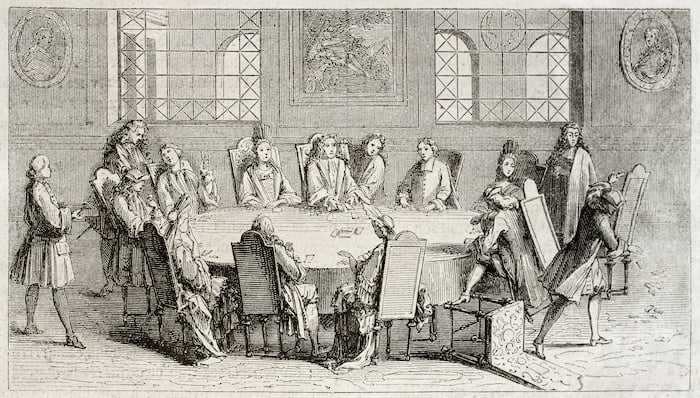The History of Playing Cards

Portable. Playable. Popular. Playing cards are the greatest gaming invention ever, simply perfection in the form of a deck of 52 cards.
Songs have been written about just about every playing card you can think of, including the Joker, the Ace of Spades, the Jack of Hearts, the Queen of Diamonds, and more. Cards have tracked down Saddam Hussein’s henchmen, singled out the volunteer, and confounded audiences in the hands of a skilled magician.
They fit in your pocket. They entertain. They bring strangers together. They are an essential tool in the armoury of any casino – both online and offline. Poker, baccarat, Caribbean stud, and blackjack are just a few examples of what happens when you combine some ingenuity with a deck of cards.
Origins of Playing Cards
The precise origins of the first playing cards are undefined. Most academics believe that China is probably where the first gaming cards came from. Dice and tokens have history stretching back to thousands of years BC because they are (obviously) not made of paper.
As with most inventions, the medium was the key. Woodblock printing on both cloth and paper was commonplace during the Tang dynasty, in 7th century China. The first reference to a ‘leaf game’, thought to be played with paper sheets, was in 868 AD. What the game and its cards looked like is lost forever.
The first specific reference to printed cards was on July 17, 1294 AD. In a court report, two players were arrested; nine cards, and the woodblocks used to print them, were impounded. Even the earliest cards followed a ‘court’ structure; with high cards represented by kings, queens, and vizier. They trumped the humble pips.

Shuffling Into Europe
Playing cards first appeared in Europe in the 14th century. At this time, they were hand painted, luxury, goods; imported into Spain and Italy by Islamic Mamluk dynasty merchants, who controlled the trade routes between Asia and the West.
Card games rapidly became the chosen pastime of the upper classes. Highly fashionable, they were the medieval equivalent of the very latest, state-of-the-art, gaming console.
As wood block printing techniques improved, becoming faster and more efficient, more cards were produced, slowly and surely finding their way along the inland European trade routes.
The generic heart, diamond, club, and spades format is thought to have evolved because of its visual simplicity and ease of printing. Stencils were used to create the patterns and the icons are easily recognised. Six hundred years later, they are still in use. If it ain’t broke…

The Oldest Playing Cards in the World
The oldest playing cards still in existence – or fragments of them at least – date back to between the 12th and 13th centuries and are thought to have come from the Middle East and Egypt. The oldest full pack to survive the ravages of time is known as the ‘Cloisters Pack’ (also known as the ‘Flemish Hunting Pack’) of oval-shaped cards. These date from between 1465 and 1480, originate in the Netherlands, and are currently on display in ‘The Cloisters’, an Upper Manhattan location of the Metropolitan Museum of Art. Instead of the familiar hearts, clubs, spades and diamonds the symbols on these cards (shown below) are hunting-themed horns, dog collars, dog leashes, and nooses. Other than this, the cards are certainly recognisable as such even to modern eyes.

A New Deal
Up until the arrival of playing cards, board games usually limited play to two people, and dice games – lacking any real intellectual stimulation – nearly always involved gambling. Card games could be played for fun and in a group. They were also popular with women.
Card games inevitably led to more gambling. European governments faced the challenge in a variety of different ways. In France, the Palace of Versailles was turned into a giant, revenue-generating, card-playing casino, following the advice of King Louis XIV’s finance minister Cardinal Mazarin.
Other legislations banned the manufacture of playing cards completely or made their production a state monopoly. In the UK, the 1765 Stamp Act meant that every deck was stamped. The tax stamp appeared on the Ace of Spades, indicating tax had been paid. This is thought to be why this card is often highly decorated.
Top Deck
Today, the world’s biggest playing card manufacturer is the United States Playing Card Company. The Kentucky-based company was established in 1867 and makes more than 100 million decks every year. Not surprising, when you consider that casinos change their cards every 6 to 8 hours. The discards are ‘cancelled’; either deformed with a drill hole, corners cut, pulped, or sold as souvenirs.
Today, the standard 52-card deck is the world’s most popular variety of playing cards. Each king in the deck represents a great king from history: Spades – King David, Hearts – Charlemagne, Diamonds – Julius Caesar, and Clubs – Alexander the Great. In the mid-19th century, Jokers were added to the pack as a high-ranking trump card.
Playing Online
Playing cards first appeared on the Internet in the mid 1990s, as online casino innovators InterCasino and Cryptologic cracked the problem of the Random Number Generator (RNG), to make online casino play as random as real play.

These days, RNGs are highly complex algorithms that ensure fair play. Sceptics now also have the option to enjoy a Live Casino experience; using real cards streamed to your desktop.
But how random is random? Here’s a (final) mind blowing fact about playing cards.
It is almost impossible to ever shuffle a deck of cards the same way twice. If every man, woman, and child on the planet shuffled a deck of cards – every single second – it would take 24,000 trillion trillion trillion times longer than the current age of the universe to produce every variation of the deck.
The number looks like this: 80,658,175,170,943,878,571,660,636,856,403,766,975,289,505,440,883,277,824,000,000,000,000.
Happy shuffling!
Source: casino.com
